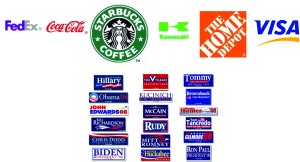What is a logo? Define the term.
There are three ‘types’ of logos–typographic, image, or a combination of the two.
The following are image based logos. All of these company logos have evolved over time. They all started with their name included in the original logo. Name the company that goes with each logo. What does it take for a company to become recognizable by an image only logo?

The following are type-based and combination image and type logos. Why would it be important to include type in a logo? Look at the FedEx logo carefully–what symbol is hiding within the letters? Was that intentional design? (Look it up!)

Pick a logo that you know has been around a while (meaning at least 10+ years.) Research the design history of that logo. How has it changed over the years? Be sure to include a link to the website you looked at in your blog post. Good websites to reference: http://www.logoblog.org/ups-logo.php
http://brandautopsy.typepad.com/brandautopsy/2005/06/the_evolution_o.html
You are going to design your own logo. Choose from:
Java Joe’s Coffee Shop
Rosemary and Thyme Catering
Board Meetings Surf Shop
UltraSwag Clothing Co.
Create a profile/background for the company. Answer the who, what, where, when and why questions about the company. Brainstorm images, fonts, layouts, shapes, colors, etc. that would help to visually illustrate the answers to these questions.
Think about which type of logo you are going to use. (hint–when designing for a brand new company, it’s pretty important to include the name for immediate company recognition!)
Sketch a minimum of 12 logo ideas for your choice of company.


